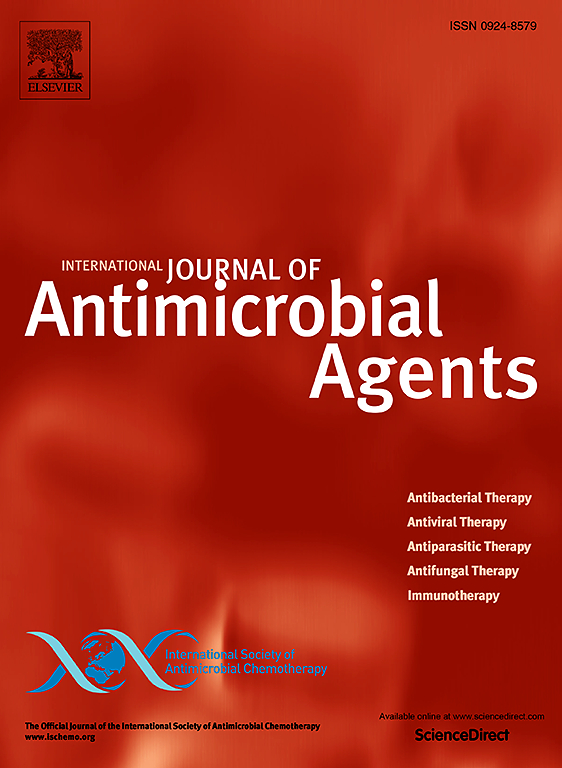Extraintestinal pathogenic Escherichia coli (ExPEC) O-serotype distribution and antibiotic resistance profiles among the aging population in China: A longitudinal, multi-center study
IF 4.6
2区 医学
Q1 INFECTIOUS DISEASES
International Journal of Antimicrobial Agents
Pub Date : 2025-09-02
DOI:10.1016/j.ijantimicag.2025.107607
引用次数: 0
Abstract
Objective
Extraintestinal pathogenic Escherichia coli (ExPEC) is a leading cause of community-acquired bacteremia and sepsis, which contributes to the substantial burden of invasive E. coli disease (IED) in older adults. This study aimed to estimate the O-serotype distribution of blood and sterile site ExPEC among older adults in China and the characteristics of antimicrobial resistance, O-serotypes, and O genotypes.
Methods
A total of 499 non-duplicated clinical isolates of E. coli derived from sterile body fluids from subjects aged ≥ 60 years from 55 medical institutions participating in the CHINET from different regions of China from 2016 to 2022 were collected. Antimicrobial susceptibility testing and whole genome sequencing (WGS) were performed for all isolates. For isolates with an O genotype pertaining to ExPEC9V (a group of 9 O-serotypes with high prevalence among bloodstream infections globally), an agglutination assay was conducted for validation.
Results
In this study, 82.2 % and 10.7 % of ExPEC isolates were tested as multidrug-resistant (MDR) and carbapenem-resistant E. coli (CREC), respectively. WGS revealed diverse STs and phylogroups. The most prevalent O serotypes were O25 (14.2 %), O75(6.2 %), O1(5.6 %), O6(4.6 %), O15(3.8 %), O45(3.6 %), O101(3.4 %), O11(3.4 %), O153(3.4 %), O8(3.4 %), O2/O50(3.0 %), and O9/O9a(3.0 %). Among MDR isolates, O25 was the dominant O serotype. 40.1 % of isolates were identified as ExPEC9V.
Conclusions
In conclusion, O25 is the most prevalent O serotype among ExPEC isolates. The ExPEC9V O-serotype prevalence is generally consistent across MDR and different sexes.
中国老年人群肠道外致病性大肠杆菌(ExPEC) o -血清型分布和抗生素耐药特征:一项纵向、多中心研究
肠道外致病性大肠杆菌(ExPEC)是社区获得性菌血症和败血症的主要原因,这是老年人侵袭性大肠杆菌病(IED)的主要负担。本研究旨在了解中国老年人血液和无菌部位exp - c的O-血清型分布,以及耐药性、O-血清型和O基因型的特征。收集2016 - 2022年中国不同地区55家参与CHINET的医疗机构中年龄≥60岁受试者无菌体液中499株无重复临床分离大肠杆菌。所有分离株均进行药敏试验和全基因组测序。对于与ExPEC9V相关的O基因型分离株(一组在全球血液感染中高流行的9种O血清型),进行了凝集试验以进行验证。在本研究中,82.2%和10.7%的ExPEC分离株分别检测为耐多药(MDR)和耐碳青霉烯(CREC)大肠杆菌。WGS显示了不同的STs和系统群。最普遍的O血清型是O25(14.2%)、O75(6.2%)、O1群(5.6%)、O6(4.6%)、O15(3.8%)、O45(3.6%)、O101(3.4%)、O11(3.4%)、O153(3.4%)、O8(3.4%)、O2 / O50(3.0%),和O9 / O9a(3.0%)。在MDR分离株中,O25是主要的O血清型。40.1%分离株为ExPEC9V。综上所述,O25是expc分离株中最常见的O血清型。在耐多药人群和不同性别人群中,ExPEC9V - o血清型患病率总体上是一致的。
本文章由计算机程序翻译,如有差异,请以英文原文为准。
求助全文
约1分钟内获得全文
求助全文
来源期刊
CiteScore
21.60
自引率
0.90%
发文量
176
审稿时长
36 days
期刊介绍:
The International Journal of Antimicrobial Agents is a peer-reviewed publication offering comprehensive and current reference information on the physical, pharmacological, in vitro, and clinical properties of individual antimicrobial agents, covering antiviral, antiparasitic, antibacterial, and antifungal agents. The journal not only communicates new trends and developments through authoritative review articles but also addresses the critical issue of antimicrobial resistance, both in hospital and community settings. Published content includes solicited reviews by leading experts and high-quality original research papers in the specified fields.

 求助内容:
求助内容: 应助结果提醒方式:
应助结果提醒方式:


